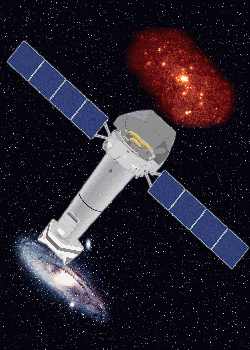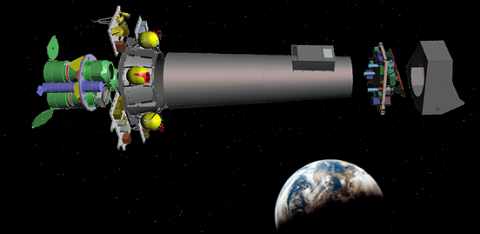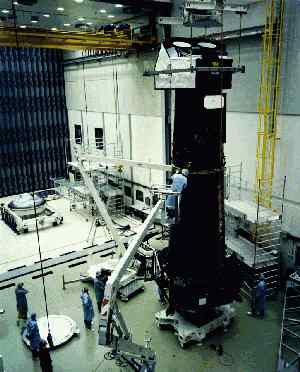


IMAGE - An artist's impression of the XMM Satellite in orbit.
Properties of XMM
| Mass | 3900 kg |
| Length | 10 m |
| Mission lifetime | 2 - 10 Years |
| Max. width (solar panel span) | 16 m |
| Total X-ray collecting area (1.5 kev) | 4300 cm2 |
| Total X-ray collecting area (8 kev) | 1800 cm 2 |
| Max. detectable X-ray energy (EPIC pn) | 15 kev |
| Min. detectable X-ray energy (EPIC MOS/pn) | 0.15 kev |
| Focal length | 7.5 m |
| Resolution (Full Width Half Maximum) | 5 arcsecs |
| Resolution (Half Energy Width) | 14 arcsecs |
| Orbital altitude (Apogee) | 7,000 km |
| Orbital altitude (Perigee) | 114,000 km |
| Power consumption (in Sun) | 1600 W |
| Power consumption (in eclipse) | 600 W |
The design of the spacecraft
At ten meters high and weighing four tonnes, XMM is the largest scientific satellite ever built in Europe. Its main payload consists of the largest X-ray telescope so far put in orbit. More info on the spacecraft can be found here and details about the spacecraft can be found here.


An important requirement with any spacecraft is that the instruments must be maintained at a reasonably uniform temperature which is not too far from the temperature at which they were tested in the laboratory. To find out how this is done, select from the menu below:
|
Thermal Design |
Instrumentation
The XMM Satellite incorporates three parallel-mounted X-ray telescopes which use Wolter mirrors to focus the X-rays onto the detector. Each of the telescopes has its own photon imaging camera to record the acquired data, and two of the cameras are also equipped with reflection grating spectrometers to measure the wavelength, and hence energy of the X-ray radiation. XMM also includes an optical/UV telescope in co-alignment with the three X-ray telescopes, which will image in visible light the region of sky containing the X-ray sources. Further details of each of XMM's instruments can be found below:
| Mirrors | |
| European Photon Imaging Camera (EPIC) | |
| Reflection Grating Spectrometer (RGS) | |
| Optical Monitor (OM) |

IMAGE - The large size of XMM is indicated by this
photograph of technicians assembling the completed spacecraft.

